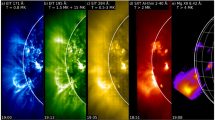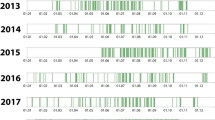Abstract
I conducted photometry of the cataclysmic variable ASASSN-V J090756.65+715859.5 and detected eclipses that were not previously known. I observed 12 eclipses. Photometric data were obtained in two compact groups of nights separated by one year. Due to the large coverage of observations and due to the fact that all eclipses had a small scatter of points, I very precisely determined the orbital period, \(P_{\mathrm{orb}}=0.152331930\pm 0.000000040\) d. The eclipse profile was asymmetric similar to eclipse profiles seen in other cataclysmic variables. The eclipse depth varied in the range 0.83(1)–1.56(4) mag and strongly correlated with the out-of-eclipse magnitude, which showed only small variations resembling stunted outbursts of nova-like variables and was between 15.22(2) and 16.12(8) mag. Using the eclipse width at half the depth (0.0563(7) phases), I estimated the minimum inclination of the orbit (\(i > 73^{\circ}\)) and the maximum absolute magnitude of the disc, 5.5–5.6 mag. This suggests that ASASSN-V J090756.65+715859.5 is a nova-like variable. I derived the long-term eclipse ephemeris, the actual validity of which is 400 years. This ephemeris is very good for studying changes in the orbital period. In addition, this ephemeris is useful for computing the orbital phases.








Similar content being viewed by others
Data Availability
The datasets generated during and/or analysed during the current study are available from the corresponding author on reasonable request.
References
Bai, Y., JiFeng, L., YiLun, W., Song, W.: Astron. J. 159, 84 (2020). https://doi.org/10.3847/1538-3881/ab63d5
Bailer-Jones, C.A.L., Rybizki, J., Fouesneau, M., Mantelet, G., Andrae, R.: Astron. J. 156, 58 (2018). https://doi.org/10.3847/1538-3881/aacb21
Baptista, R., Catalán, M.S., Costa, L.: Mon. Not. R. Astron. Soc. 316, 529 (2000). https://doi.org/10.1046/j.1365-8711.2000.03557.x
Boch, T., Fernique, P.: In: Manset, N., Forshay, P. (eds.) Astronomical Data Analysis Software and Systems XXIII. Publ. Astron. Soc. Pac. Conf. Series, vol. 485, p. 277 (2014)
Bonnarel, F., Fernique, P., Bienaymé, O., et al.: Astron. Astrophys. Suppl. Ser. 143, 33 (2000). https://doi.org/10.1051/aas:2000331
Brown, A.G.A., Vallenari, A., Prusti, T., et al. (Gaia Collaboration): Astron. Astrophys. 649, A1 (2021). https://doi.org/10.1051/0004-6361/202039657
Hardy, L.K., McAllister, M.J., Dhillon, V.S., et al.: Mon. Not. R. Astron. Soc. 465, 4968 (2017). https://doi.org/10.1093/mnras/stw3051
Hellier, C.: Cataclysmic Variable Stars. Springer, Chichester (2001)
Honeycutt, R.K., Robertson, J.W., Turner, G.W.: Astron. J. 115, 2527 (1998). https://doi.org/10.1086/300381
Horne, K.: Mon. Not. R. Astron. Soc. 213, 129 (1985). https://doi.org/10.1093/mnras/213.2.129
Jayasinghe, T., Kochanek, C.S., Stanek, K.Z., Shappee, B.J., Holoien, T.W.-S., et al.: Mon. Not. R. Astron. Soc. 477, 3145 (2018). https://doi.org/10.1093/mnras/sty838
Kozhevnikov, V.P.: Astrophys. Space Sci. 363, 130 (2018). https://doi.org/10.1007/s10509-018-3351-9
Kozhevnikov, V.P.: New Astron. 77, 101350 (2020). https://doi.org/10.1016/j.newast.2019.101350
Kozhevnikov, V.P.: Astrophys. Space Sci. 366, 111 (2021). https://doi.org/10.1007/s10509-021-04015-4
Kozhevnikov, V.P., Zakharova, P.E.: In: Garzon, F., Eiroa, C., de Winter, D., Mahoney, T.J. (eds.) Disks, Planetesimals and Planets. Publ. Astron. Soc. Pac. Conf. Series, vol. 219, p. 381 (2000)
la Dous, C.: Space Sci. Rev. 67, 1 (1994)
Ochsenbein, F., Bauer, P., Marcout, J.: Astron. Astrophys. Suppl. Ser. 143, 23 (2000). https://doi.org/10.1051/aas:2000169
Prusti, T., de Bruijne, J.H.J., Brown, A.G.A., et al. (Gaia Collaboration): Astron. Astrophys. 595, A1 (2016). https://doi.org/10.1051/0004-6361/201629272
Schwarzenberg-Czerny, A.: Mon. Not. R. Astron. Soc. 241, 153 (1989). https://doi.org/10.1093/mnras/241.2.153
Schwarzenberg-Czerny, A.: Mon. Not. R. Astron. Soc. 253, 198 (1991). https://doi.org/10.1093/mnras/253.2.198
Schwarzenberg-Czerny, A.: Balt. Astron. 7, 43 (1998). https://doi.org/10.1515/astro-1998-0109
Sesar, B., Hernitschek, N., Mitrović, S., Ivezić, Ž., Rix, H.-W., et al.: Astron. J. 153, 204 (2017). https://doi.org/10.3847/1538-3881/aa661b
Warner, B.: Cataclysmic Variable Stars. Cambridge Astrophys. Ser., vol. 28. Cambridge University Press, Cambridge (1995)
Acknowledgements
The work of V.P. Kozhevnikov was supported by the Ministry of science and higher education of the Russian Federation, agreement FEUZ-2023-0019. The author is grateful to the ZTF team for making their data available to the public. This research has made use of NASA’s Astrophysics Data System Bibliographic Services, the VizeR catalogue access tool (Ochsenbein et al. 2000) and the Aladin sky atlas developed at CDS, Strasbourg observatory, France (Bonnarel et al. 2000; Boch and Fernique 2014). This work has made use of data from the European Space Agency (ESA) mission Gaia (https://www.cosmos.esa.int/gaia), processed by the Gaia Data Processing and Analysis Consortium (DPAC, https://www.cosmos.esa.int/web/gaia/dpac/consortium).
Funding
Funding for the DPAC has been provided by national institutions, in particular the institutions participating in the Gaia Multilateral Agreement.
Author information
Authors and Affiliations
Contributions
I, Valerij Kozhevnikov, is the only author of the manuscript. All content of the manuscript is prepared by me.
Corresponding author
Ethics declarations
Competing interests
The authors declare no competing interests.
Additional information
Publisher’s Note
Springer Nature remains neutral with regard to jurisdictional claims in published maps and institutional affiliations.
Rights and permissions
Springer Nature or its licensor (e.g. a society or other partner) holds exclusive rights to this article under a publishing agreement with the author(s) or other rightsholder(s); author self-archiving of the accepted manuscript version of this article is solely governed by the terms of such publishing agreement and applicable law.
About this article
Cite this article
Kozhevnikov, V.P. Discovery of eclipses in the cataclysmic variable ASASSN-V J090756.65+715859.5. Astrophys Space Sci 368, 89 (2023). https://doi.org/10.1007/s10509-023-04245-8
Received:
Accepted:
Published:
DOI: https://doi.org/10.1007/s10509-023-04245-8




